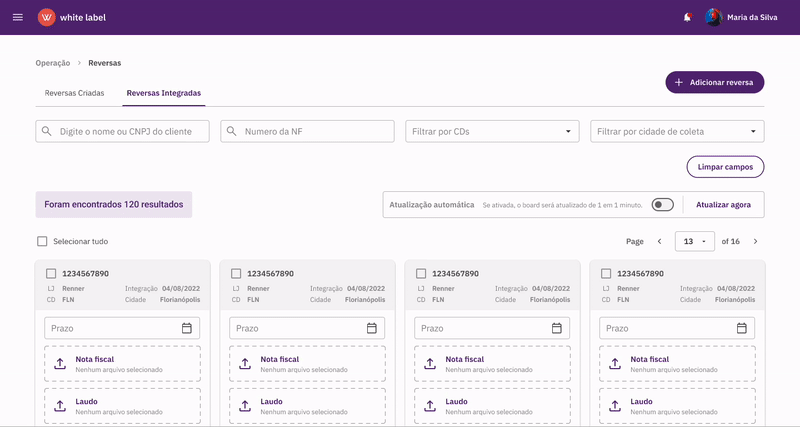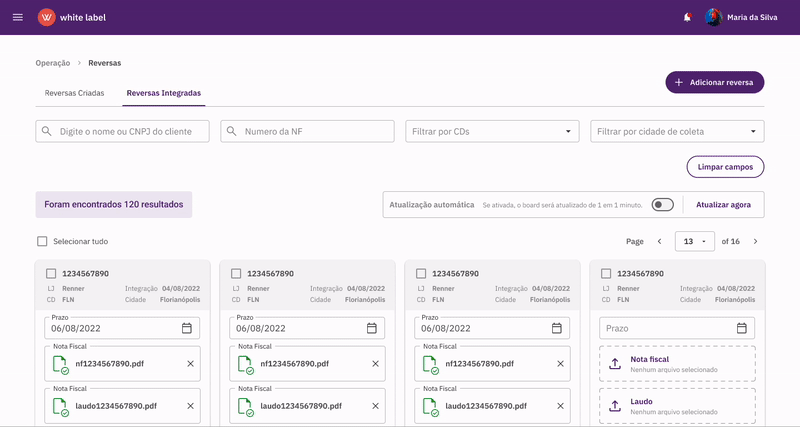Reverse pick-up request process
Issuing reverse pick-up orders through data integration between TMS platforms.

What you'll find in this case
Important numbers
About the project
Summary
Outcome:
Feature
Date:
2022
My role:
Sole product designer
Team:
1 Business Analyst, 2 developers
Industry:
Logistics
Company context
This case study focuses on a logistics company that provides transport services for e-commerce businesses without their own delivery operations.
To manage its logistics, the company uses its own Transportation Management System (TMS) alongside a third-party system. However, the integration between these systems is being developed incrementally, meaning that some operations, such as Reverse Pick-up, are not yet fully automated.
What is Reverse Pick-up?
Reverse Pick-up is the process of retrieving a previously delivered item from a recipient's address so that it can be returned to the retailer. This typically occurs when the customer needs to return or exchange a product. The process works as follows:
1. The recipient contacts the retailer to request a return.
2. The retailer submits a reverse pick-up request to the company's Customer Service (CS) team.

3. The CS team processes the request using both the company’s internal TMS and the third-party system.
4. The company executes the pick-up using an existing Reverse Pick-Up module to track the process.
01. Discovery
Understanding the current workflow
How it works
Currently, the Reverse Pick-up process is manually handled across two different systems due to the lack of full integration. Here’s how it works:
• The Customer Service team manually registers the request in both the third-party system and the company’s internal system.
• The lack of integration means that information is duplicated, requiring users to copy and paste data from one system to the other.
Current workflow

• The request is then forwarded within the internal system to the Operations team, who oversee the execution of the pick-up.
Key problem
The manual and repetitive nature of this workflow increases workload, time consumption, and the risk of human error for the Customer Service team.
01. Discovery
Brainstorming
During an initial brainstorming session, we explored:
• User needs and pain points.
• Technical feasibility of integration.
• Potential workflow improvements.
Main insights
• Full automation was not feasible due to variations in how different Distribution Centers handle reverse pick-ups.
• For the integration to happen correctly, users would need to manually rename certain files, which could lead to errors.
• Instead of 20+ fields per request, we could reduce inputs to just 3 through partial automation.

Points raised and discussed in the brainstorm session
01. Discovery
User interview
We conducted user interviews to validate our assumptions and refine our approach.
Key takeaways
• The existing Reverse Pick-Up module was not the ideal place for the new integration, as it would clutter the interface and did not align with the CS team’s workflow.
• The CS team primarily needed visibility into which Distribution Center was handling each request to complete the missing details before forwarding it.
• A new screen would be necessary to display the integrated data clearly and enable bulk actions for efficiency.

Supposition flowchart
02. Definition
User requirements
After consolidating insights from brainstorming and interviews, we defined the following key requirements:
• A new screen within the Reverse Pick-up module to display integrated data from the third-party system.
• Clear, structured information to help users quickly fill in missing details and forward requests efficiently.
• Bulk actions to allow multiple requests to be processed at once.
User stories
1st user story
01. As a(n)...
Customer Service representative
02. I want to...
see which Distribution Center is responsible for the reverse pick-up and who the client is
03. So that...
I can input the correct execution deadline
2nd user story
01. As a(n)...
Customer Service representative
02. I want to...
set the deadline for a reverse pick-up order before forwarding it
03. So that...
the Operations team can process it accurately
3rd user story
01. As a(n)...
Customer Service representative
02. I want to...
I want to attach invoice and report files easily
03. So that...
so that I can increase productivity during my working hours
02. Definition
New workflow
With validated insights, we designed an improved workflow:
1. The process still begins with the Customer Success team issuing a request in the third-party system.
2. The integration automatically transfers most of the data to the internal system.
3. A new section in the Reverse Pick-up module allows the CS team to review and complete any missing details (now just 3 fields instead of 20!).
4. The request is then forwarded to the Operations team for execution.

Future workflow

What the flow will look like once the data is integrated
03. Design
Low fidelity wireframes
We explored multiple interface options, considering existing system patterns such as tables and kanban views. Users were presented with two variations:
1. A table view, where each row represented an integrated reverse pick-up.
2. A grid-style list of cards.
Surprisingly, users preferred the grid layout, highlighting the importance of involving them in decision-making early on.

Low fidelity wireframes.
03. Design
Interface
Note: The final UI below was designed using a white-label pattern library (developed by me) to maintain brand consistency while protecting proprietary elements.
1. Integrated reverse pick-ups page

2. Select deadline

3. Attach files

4. Forward request

03. Design
Handoff
The design handoff involved:
• Figma documentation detailing screen layouts and component behaviors.
• A kickoff meeting where I presented the high-fidelity prototype.
• A collaborative Q&A session with developers to ensure clarity before coding began.

An overview of how I usually organise handoff files.
4. Monitoring
Important numbers
Automation boost
Before implementation, only ~70% of the reverse pick-up request process was automated. With the new integration, this increased to 90–95%.
Increased efficiency
The number of reverse pick-up orders issued per period reversed its downward trend to an upward one. Thanks to improved efficiency, the CS team was able to process more requests in the same amount of time, supporting the company’s delivery goals.


Amount of issues per month in 2022.
Amount of issues per month in 2023.
To wrap it up
Final notes
This project was particularly meaningful as it was one of my first designs as the sole Product Designer on the team. It was both a challenge and an opportunity to:
• Adapt to a new environment while quickly understanding business and user needs.
• Collaborate closely with developers to create a feasible and impactful solution.
• Improve an existing process that directly enhanced user productivity.
Even though 100% automation wasn’t possible, the reduction in manual effort and increase in efficiency made a tangible difference for the users—an outcome that reflects the true value of design in solving business problems.